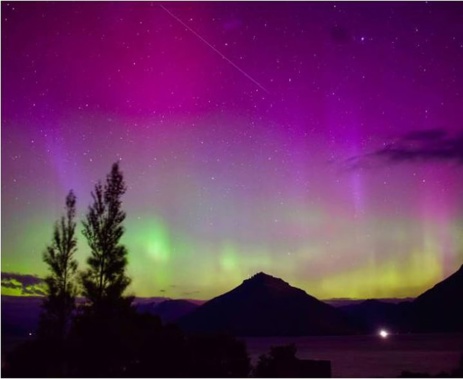
Aurora chasers across the South were treated to clear skies as bright beams of light visible to the naked eyed streaked through a starry backdrop to start the week.
Photographers’ images flooded social media yesterday.
Georgia Wallis, of Queenstown, said she took a friend, who had never seen the southern lights, to the beach at Jacks Point, on Lake Wakatipu, when she went to photograph the aurora australis on Monday.
Wallis, a native of Cornwall, England, called her mother yesterday morning and she was off to see the same solar storm from the south of England, such was its strength.
Wallis said she was worried to start the night because “there were a few clouds”.
Soon, though nature put on a “stunning” display and she took photographs about 10.45pm.
“This is the brightest one I’ve ever seen, even with the naked eye.
“It was just so bright, you could see the beams in the sky — it was just amazing.
“My mum has actually gone out tonight to photograph the aurora borealis [northern lights], because it’s also meant to be visible there.
“I saw it here and when I woke up in the morning, she was off to see the one on the other side of the world.”
Otago Museum director and astrophotographer Dr Ian Griffin said Monday night’s display was due to a couple of recent events called “coronal mass ejections” — charged particles being ejected from the sun.
“That sounds terribly complicated, but what it is is basically the sun fires material occasionally towards Earth.
“And we’ve had two of those ejections in the last two days.”
Both were travelling between the Sun and the Earth at about 800km per second.
When that material hit the earth’s magnetic field it started to spiral around it, he said.
As it spiralled around, passing through the Earth’s atmosphere, it made the Earth’s atmosphere glow.
“That’s why the sky was literally aglow all night last night.”
Normally, that material was quite “benign” and people only saw auroras in quite high latitudes, Dr Griffin said.
However, when there were “big coronal mass ejections” like those in the last couple of days, people started to see auroras much further north in the southern hemisphere.
He was out photographing the skies from after midnight until dawn yesterday.
Some of the beams he saw on display from Hoopers Inlet were very nearly overhead, he said.
“That means the action is almost overtop of New Zealand, which is quite rare.”
The colours people saw were caused by different gases — the green colour people normally saw with auroras was oxygen, purple was nitrogen.
“The colours on cameras are absolutely ridiculous this time, because they are so intense.
“You could literally see a very bright green colour.
“I saw reds early in the display as well and that’s really rare.
“That’s another testament to how strong this storm was.
“And the fact of the matter is it’s still raging.”
- Hamish MacLean, ODT
Take your Radio, Podcasts and Music with you









